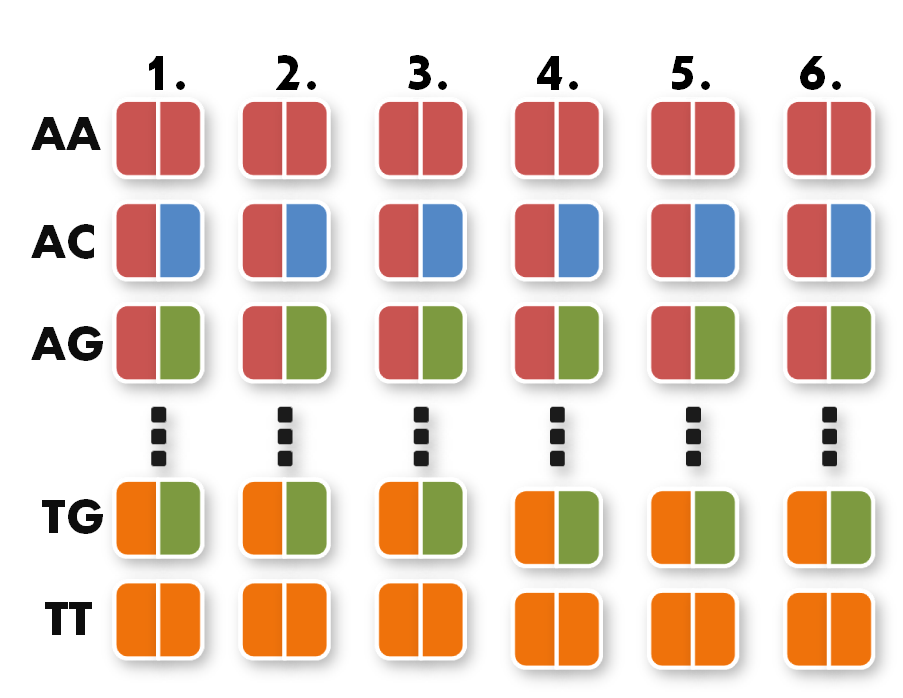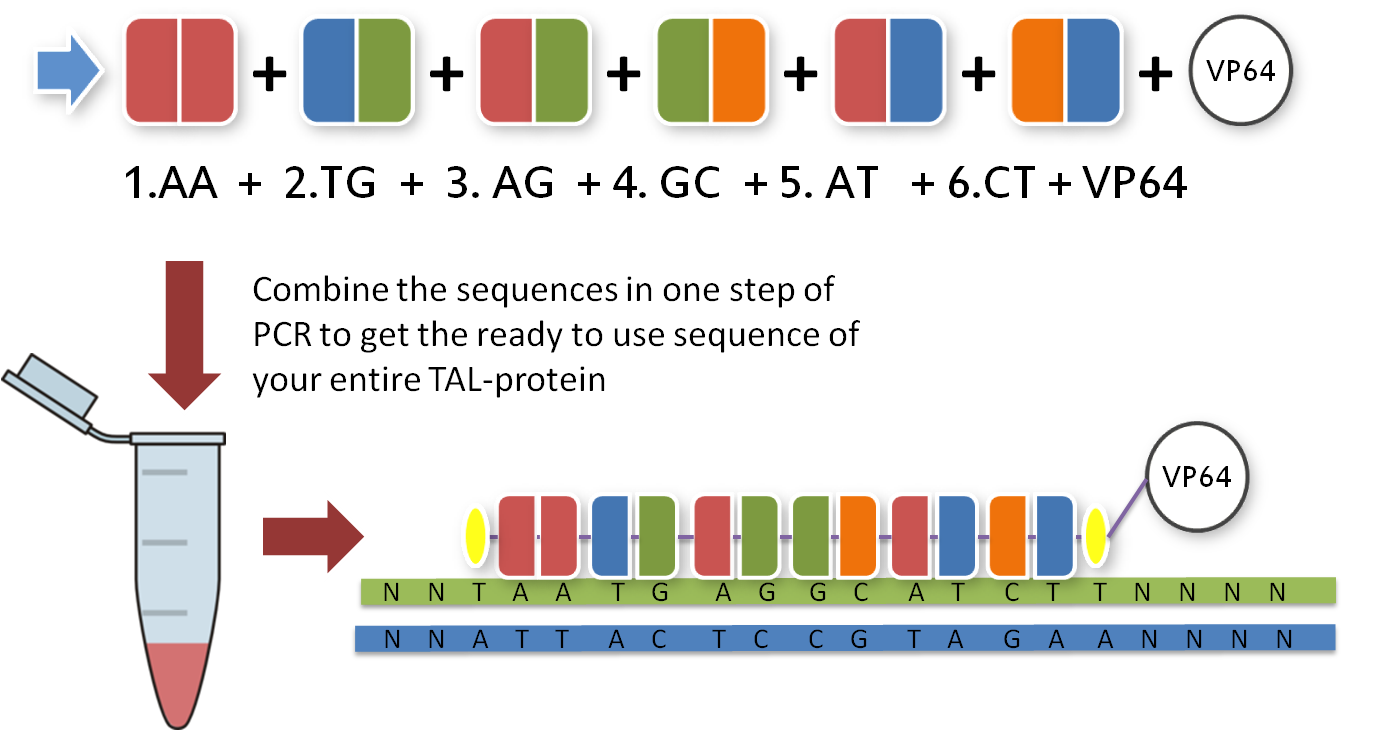Team:Freiburg/Project/Tal
From 2012.igem.org
| Line 51: | Line 51: | ||
---- | ---- | ||
| - | Here we try to give you something like a short manual on how to use our toolkit to design TAL poteins. | + | Here we try to give you something like a short manual on how to use our toolkit to design TAL poteins. We recommend reading through all of the manual first before putting anything together. |
| Line 73: | Line 73: | ||
| - | =<span style="color:#2244AA"> Step | + | =<span style="color:#2244AA"> Step 2. Building a TAL = |
For building your TAL you start with your selected sequence, in this amnual we use a fictive sequence that you can substitute with your own. <p>Our sequence will be:</p> | For building your TAL you start with your selected sequence, in this amnual we use a fictive sequence that you can substitute with your own. <p>Our sequence will be:</p> | ||
| Line 114: | Line 114: | ||
|[[Image:sequence5.png|500px|no frame]] | |[[Image:sequence5.png|500px|no frame]] | ||
|} | |} | ||
| + | |||
| + | |||
| + | |||
| + | =<span style="color:#2244AA"> Step 3. Adding a Function = | ||
| + | |||
| + | |||
| + | Now that you have your TAL biobricks you a almost ready to start working. But targeting a sequence without doing anything is not really helpfull, you need a fusion protein that does something to your DNA. There are a couple of things you could do with your target sequence and normally you have thought of this before you choose your sequence. With our toolkit you get a transcriptionfactor to turn on or enhance the trancription of a gen, a transcriptionfactor to turn down or off the transcription and several other factors like epigeneticmodificators. Every one of these factors is designed to fit at the 3'-end of your TAL biobricks, so you just have to choose one and put it in your reaction tube to the other biobricks. | ||
| + | |||
| + | |||
| + | {|align="center" | ||
| + | |[[Image:TALfunction.png|600px|no frame]] | ||
| + | |} | ||
| + | |||
| + | |||
| + | With the six TAL biobricks the fusion enzyme and also the TAL backbone in your reaction tube you now only need the typ two restriction enzyme BsmB1 and a T4 Ligase to put all the parts together. | ||
Revision as of 15:47, 9 September 2012
| Home | Team | Official Team Profile | Project | Parts Submitted to the Registry | Modeling | Notebook | Safety | Attributions |
|---|
| Building a Toolkit | Using the Toolkit | Experiments |
|---|
Using the Toolkit
Here we try to give you something like a short manual on how to use our toolkit to design TAL poteins. We recommend reading through all of the manual first before putting anything together.
Step 1. The Experiment
First you need to think about your experiment and what you want to do, when working with TAL proteins its pretty clear you want to target a dna sequence. To choose your sequence you need to know some of the limitations of TAL proteins to pick it the right way.
1. Every TAL protein starts and ends with a Thymin
This Thymin is already inserted in front of your TAL protein when you use our toolkit but it should also be in front of the first base of your sequence
2. Your sequence must be twelve bases long
Our Toolbox is optimized for sequences of twelve plus two (the thymin at upstream and downstrem) this lenght guarantes a high enough specifity and at the same time a librarysize that good to handle.
If you found a sequence that suits these limitations you can start building your TAL protein.
Step 2. Building a TAL
For building your TAL you start with your selected sequence, in this amnual we use a fictive sequence that you can substitute with your own.Our sequence will be:
Because the two thymins are already in the cloning vector they are not intresting for our TAL protein:
To build this sequence from our toolkit we need to split it up in pairs of two:
Now we need to give our pairs position numbers inside the TAL protein:
Now we can start taking the parts out of the toolkit. A short look at the toolkit shows you that for every posible pair of bases like for example AA we have 6 places. Every place stands for one of the six possiple positions of the pair AA inside the TAL protein.

|
All you have to do know is pick the six direpeats consistend with the six pairs of bases of your sequence. In our case we would take the the first one of AA beacuse teh first pair of bases in our sequence is AA then we take the second one of TG the third of AG and so forth. The idea behind this that every direpeat knows through his downstream and upstream part at which position of the final TAL protein it belongs. You can find the exact theory behind this in the "Building a toolkit" part in the project section of this wiki.

|
Step 3. Adding a Function
Now that you have your TAL biobricks you a almost ready to start working. But targeting a sequence without doing anything is not really helpfull, you need a fusion protein that does something to your DNA. There are a couple of things you could do with your target sequence and normally you have thought of this before you choose your sequence. With our toolkit you get a transcriptionfactor to turn on or enhance the trancription of a gen, a transcriptionfactor to turn down or off the transcription and several other factors like epigeneticmodificators. Every one of these factors is designed to fit at the 3'-end of your TAL biobricks, so you just have to choose one and put it in your reaction tube to the other biobricks.

|
With the six TAL biobricks the fusion enzyme and also the TAL backbone in your reaction tube you now only need the typ two restriction enzyme BsmB1 and a T4 Ligase to put all the parts together.
 "
"
